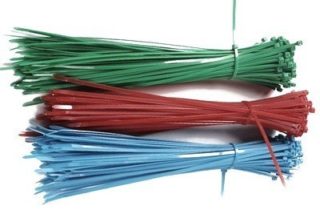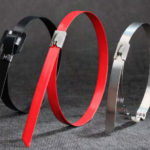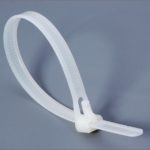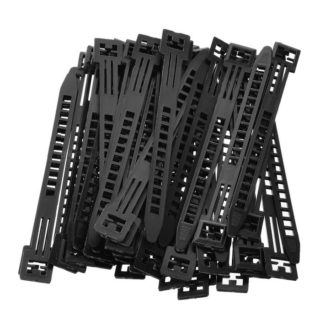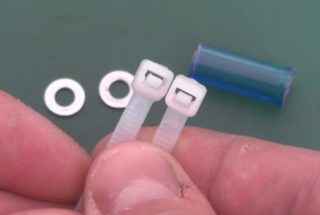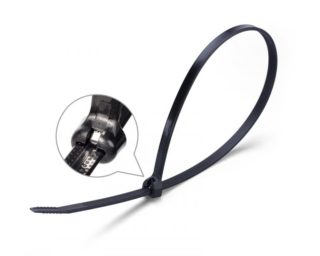Most modern technology is powered by electricity. Connection requires wires that can become tangled with each other and be damaged. To prevent cables from being tangled, cable ties are used to fix them into a single bundle. Before you buy clamps for wires with fastening, you should understand their varieties.
Requirements for cable ties and their types
Cable bandages have a number of requirements that must be observed for high-quality and long-term performance:
- high clamp strength;
- long service life of cable ties;
- reliability of fixation;
- keeping the bundle of cables in a tightened state for a long time;
- fire resistance;
- resistance to external negative factors;
- wide range of operating temperatures.
In construction stores you can buy screeds of various shapes (stripes, spirals), lengths and made of different materials. The width is usually a few mm. Also, products are classified by type of castle system.
Material classification
Depending on the material of manufacture, the screeds are divided into the following categories:
- Plastic Two types are made - polyamide and polyethylene. They have a wide range of operating temperatures - from -40 ° to + 80 °. Plastic cable ties for wiring fasteners are inexpensive, easy to work with, as they are soft and flexible. The disadvantages include the unreliability of the lock connection and the complexity of installation due to the plasticity of the material. They are used only indoors; it is forbidden to use outdoors.
- Metal. Created from stainless steel, there are also models with additional PVC coating. These are the most durable tensile clamps for electrical wiring. They can work at temperatures from -80 ° to + 500 °. Non-combustible, can be used outdoors. The disadvantage is the high cost.
- Steel
- Plastic
Coal-based plastic ties can be used outdoors. The addition of coal makes them more resistant to ultraviolet radiation.
Reusable classification
Disposable single-use bandages and one-piece locks are most common on the market. But you can also purchase a universal reusable product. Such clamps for wiring have two eyes, thanks to which you can connect the bandages in a chain of the desired length. Such screeds have found their application not only in electrical work, but also in the household. With their help, you can shorten the cables by fixing the unnecessary part, and attach them to the wall. Thanks to the fasteners, the workplace will always be neat, and the wires will not interfere underfoot.
Reusable items include Velcro fasteners. They allow you to quickly and easily fix the wire and add new harnesses. Made of nylon or polyethylene. Usually plastic items are attached with such ties.
Electric couplers are used not only for connecting cables to a bundle, but also for marking bundles or wires. For this, colored products are used. Also, a small area can be applied on the screeds, on which you can leave inscriptions about the purpose of the beam. The pad looks like a wrapper or flag.
Types of locks for screeds
In addition to the classification according to the material, the screeds can be divided by the type of locking system. Available types of locks for sale:
- standard;
- with a metal tooth;
- ball;
- reinforced.
Each of the species has its own principle of action.
Standard lock
It is a strip made of plastic or metal. The strip is marked with sawtooth protrusions on the inside. On one edge of the screed is a lock that looks like a small box with a latch installed in it. Sawtooth protrusions are also applied on the locking mechanism, due to which the clamp does not open.
The cable clamp must be wrapped around a group of cables. The free end is held in the lock in a special slot. Next, the screed must be tightened. The reverse stroke in the bandages of this kind is absent.
Metal tooth lock
A metal plate or tooth is mounted on the inside of the lock on a plastic bandage. Usually made of stainless steel. The tooth should be set at an angle of 45 ° to the strip. Sharpening must also be applied. When the cables are pulled together, the strip can move freely in the lock; if you try to pull it back, the tooth will block it. Tighten tightly to tighten the wires more accurately and reliably.
Ball lock
These types of locking mechanisms are used in metal bandages. The lock is a metal case in the form of a cone, in which there is a metal ball. During tightening, the ball is pushed into the wide part, while trying to pull the strip back the ball goes into a narrow area and blocks it.
Lock for reinforced clamp
Such systems have sawtooth protrusions that are located on the outside of the nylon retaining strip. The lock has large teeth.
Reinforced clamps can be issued with a single and double lock.
Wire Binding Recommendations
For prolonged use, do not tighten the ties very much. It can also damage the wires.
If you plan to add new and remove old wires, you should give preference to reusable clamps.
For the street, you need to select bandages that are resistant to ultraviolet radiation, moisture and other atmospheric precipitation.
